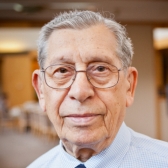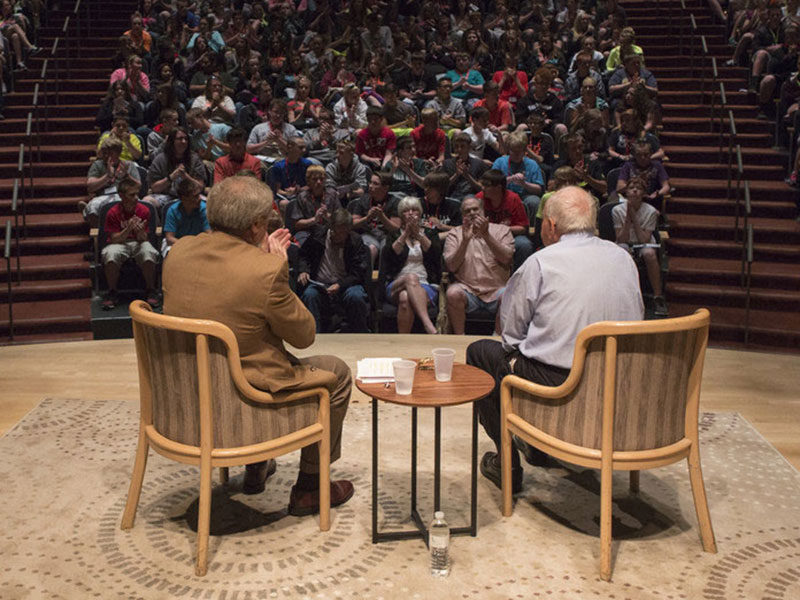August 19, 2009
Haim Solomon discusses hiding during the pogrom that Romanian authorities staged against the Jewish population in Iasi, Romania, within days of the German invasion of the Soviet Union in June 1941. Haim and his family hid in various different locations across the city. At least 4,000 Jews were murdered in Iasi during the pogrom.
LISTEN
TRANSCRIPT
HAIM SOLOMON:
Aligned on both sides were Romanians, Germans, Romanian, German, and as the Jews passed by, they split their heads or shot them in their temple.
NARRATOR:
Over 60 years after the Holocaust, hatred, antisemitism and genocide still threaten our world. The life stories of Holocaust survivors transcend the decades and remind us of the constant need to be vigilant citizens and to stop injustice, prejudice and hatred wherever and whenever they occur.
This podcast series presents excerpts of interviews with Holocaust survivors from the United States Holocaust Memorial Museum’s public program First Person: Conversations with Holocaust Survivors.
In today’s episode Haim Solomon talks with host Bill Benson about his experiences during the pogrom in Iasi, Romania. Within days of the German invasion of the Soviet Union in June of 1941, Romanian authorities staged a pogrom against the Jewish population in Iasi. Haim and his family hid in various different locations across the city.
BILL BENSON:
Of course, all of that would just change dramatically. Even though you’ve already had one major change of being forced to move to Iasi, once the Germans, as they were amassing to do, invaded the Soviet Union in 1941, the Jews in Iasi, thousands and thousands of them as you described, were subjected to a vicious pogrom. Would you tell us what happened and what a pogrom is.
HAIM SOLOMON:
1941, June 21, Germany invaded the Soviet Union and German tanks, singing soldiers were marching all over the city. We stayed indoors and watched them from windows. On June 26th, the Soviet Union Air Force bombed the train station in Iasi and many victims they suffered but the Germans, or the Romanians insisted that Jewish Communists signaled the Soviets where to bomb, drop the bombs. So, they initiated a vicious, barbaric, animalic, pogrom in Iasi with the scenario that they utilized in many other occasions, they asked the Jews to come to the city hall and exchange their old identification cards with new ones.
Once they got there and because soldiers and policemen kept bringing waves of more and more Jews, they as they cross the street, the police center had a big yard surrounded by a stone wall. And as they entered from the police, from the city hall to that stone yard, stone wall yard, aligned on both sides were Romanians, Germans, Romanian, German, etc. That was for the Germans to teach the Romanians what to do and as the Jews passed by, they split their heads or shot them in their temple because the Jews were holding their hands up.
So that the yard, the courtyard of that police station filled up with dead or dying Jews. My two brothers Reuven and Henry they slept in the store, about 10 blocks away from the house. They decided to go to the city hall to get their new identification cards. Reuven lost his card, old ID card and went into a relative to inquire and they convinced him not to go any place, but Henry kept going. As he entered and passed through all these Germans and Romanian guards he found himself next to the back wall and as night started, they jumped over the wall and look for a nice place, or a good place, to hide. They found a house with a big cross painted on it, which tells us that the whole thing was scheduled, prepared and not immediately orchestrated. So they went into the yard…
BILL BENSON:
So it was a cross painted on it saying, “Leave this one alone.”
HAIM SOLOMON:
Correct. They went into the yard and found a shed with fire wood, stacked all the way to the ceiling. They removed the top layer and crawled into it and replaced the layers so that guards, Germans, came to look then they saw the wood up to the ceiling and left. So they lay there, lie there quietly for five to six days. Back to the yard, the police and the Germans shooting people or wounding them. For a day before the 29th, between one o’clock and six, seven o’clock in the evening, they killed 4.000 people coming into that yard.
The next day they brought in the trash disposal, garbage removal, carts. Those were horse drawn carts to remove the dead and take them to the Jewish cemetery. The rest of the Jews they walked them to the train station and there they filled up train cars, that would hold 50-60 people they put 120 in each car and started them on a long travel, a long trip that went back and forth and June 29th, July 1st, under the heat and without water, half of them were dead when they arrived in the first village, Podul Iloaei. They removed the dead but then did not leave the 60 or so people by themselves, no they brought in more from back, guards to again fill up the train with 100, 120 people.
Things quieted down after five, six days and we started getting out of the house.
BILL BENSON:
Haim, tell us how you and the others in your family managed to not get caught up in that.
HAIM SOLOMON:
Yes, as I said, brothers were away from the house and from our father and so they decided to go. The house where my father…he indicated no one is going and none of the neighbors would go. So this corner house that we had with three streets had three entrances so that when they came to look for us, Mother would stand with the daughters, would stay out, indicate, tell them that we already went. And that was good for them. Because among the dead there were 40 women and over 100 children. Those were families that would not separate. They would all go together. So, there were 40 women and 110 children among the victims.
BILL BENSON:
So the vast majority were Jewish men…males?
HAIM SOLOMON:
Correct, mostly Jewish men.
BILL BENSON:
And while the Germans or Romanians came to look for you, because you had multiple exits, you were going out the back exits.
HAIM SOLOMON:
Correct. We were out one another exit when they came to one of them. That basement also had small windows and we could look out and see Jews being marched and kicked and shot if they couldn’t move faster. The Rabbi of the nearby temple was killed on the street and left there. Some neighbors went to take him and bring him in. After five, six days, we started moving out of the hiding.
Streets were still empty, and really scary. Cats, dogs were licking blood from puddles.
NARRATOR:
You have been listening to First Person: Conversations with Holocaust Survivors, a podcast series of the United States Holocaust Memorial Museum. Every Wednesday at 1 p.m. from March through August, Holocaust survivors share their stories during First Person programs held at the Museum in Washington, DC. We would appreciate your feedback on this series. [Please take our First Person podcast survey (external link) and let us know what you think.]
[On] our website you can also learn more about the Museum’s survivors, listen to the complete recordings of their conversations, and listen to the Museum podcasts Voices on Antisemitism and Voices on Genocide Prevention.


